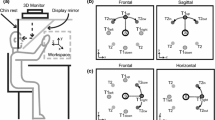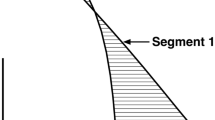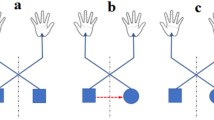Abstract.
Previous studies addressing the problem of the control of multiple degrees of freedom have examined the influence of trunk movement on pointing movements within the arm's reach. Such movements may be controlled by two functionally independent units of coordination (synergies): one involving only arm joints and producing the hand trajectory to the target (the transport synergy), and the other coordinating trunk and arm movements leaving the hand trajectory unchanged (the compensatory synergy). The question of whether or not this functional subdivision depends on visual feedback was addressed in the present study. We also tested whether or not the motor effects of different synergies are summated as independent components, a control strategy called "superposition." Finally, we investigated whether or not the relationship between different degrees of freedom within each synergy could be considered linear resulting in proportional changes in different joint angles. Seated subjects produced fast, uncorrected arm movements to an ipsi- or a contralateral target in the direction of ±45° to the sagittal midline of the trunk. Targets could be reached using the arm alone (control trials) or by combining the arm motion with a forward or backward trunk motion produced by hip flexion or extension (test trials), with and without visual feedback. The shape of the hand trajectory, its direction and tangential velocity, movement precision, joint angles and the sequence of the trunk and hand recruitment and de-recruitment were measured. In both visual conditions, the direction of the hand trajectory observed in control trials was generally preserved in test trials. In terms of sequencing, even in the absence of vision, the trunk movement was initiated before the onset of and outlasted the hand shift, indicating that the potential influence of the trunk on the hand movement was compensated by rotations in the elbow and shoulder joint. The analysis of other variables also implied that the effects of trunk recruitment on the hand trajectory were minor compared to those which could be observed if these effects were not compensated by appropriate changes in the arm joint angles. It was concluded that an arm-trunk compensatory synergy is present in pointing movements regardless of visual feedback. Principal component analysis showed that the relationship between elbow, shoulder and hip joint angles in individual arm and combined arm-trunk movements cannot be considered linear, implying that this relationship is adjusted according to the changing arm geometry. The changes in each arm joint angle (elbow, shoulder) elicited by a forward trunk bending in one block of trials were compared with those elicited by a backward bending in another block, whereas the hand moved to the same target in both blocks. These changes were opposite but of similar magnitude. As a result, for each moment of movement, the mean joint angle obtained by averaging across two directions of trunk motion was practically identical to that in control trials in which the trunk was motionless. It is concluded that the transport and arm-trunk compensatory synergies are combined as independent units, according to the principle of superposition. This principle may simplify the control of the coordination of a redundant number of degrees of freedom.
Similar content being viewed by others
Author information
Authors and Affiliations
Additional information
Electronic Publication
Rights and permissions
About this article
Cite this article
Pigeon, P., Yahia, L., Mitnitski, A. et al. Superposition of independent units of coordination during pointing movements involving the trunk with and without visual feedback. Exp Brain Res 131, 336–349 (2000). https://doi.org/10.1007/s002219900267
Received:
Accepted:
Issue Date:
DOI: https://doi.org/10.1007/s002219900267




